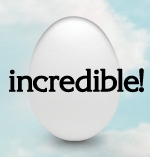If there’s one thing I’ve learned about applied storytelling, it is that there is virtually no subject to which storytelling cannot be applied. Here’s a little roundup of interesting storytelling applications:
-
- The American Egg Board collects what I thought were egg stories
 at its Gather.com site, Incredible, but on further inspection, these turn out to be stories in which “some Incredible People are doing some incredible things to change [childhood obesity]. Hear their inspirational stories and share your own.” The stories I saw didn’t seem to fit that description. I did see a Christmas morning story, reminding me that I could easily submit a story about my famed eggs-and-wine-sauce that I make every Christmas morning. This story, however, is the antithesis of a story to fight childhood obesity in that my recipe will clog your arteries in a New York minute. On the flip side, I’m on my biannual, two-week Fat Flush diet in which I get a puny scrambled egg for breakfast each day. (and on a related note, successful fat-flushers tell their stories here.)
at its Gather.com site, Incredible, but on further inspection, these turn out to be stories in which “some Incredible People are doing some incredible things to change [childhood obesity]. Hear their inspirational stories and share your own.” The stories I saw didn’t seem to fit that description. I did see a Christmas morning story, reminding me that I could easily submit a story about my famed eggs-and-wine-sauce that I make every Christmas morning. This story, however, is the antithesis of a story to fight childhood obesity in that my recipe will clog your arteries in a New York minute. On the flip side, I’m on my biannual, two-week Fat Flush diet in which I get a puny scrambled egg for breakfast each day. (and on a related note, successful fat-flushers tell their stories here.) - Scott Sheppard, a software development manager at Autodesk Labs, blogs at It’s Alive in the Lab and not long ago wrote a nicely illustrated entry on storytelling in architecture:
- The American Egg Board collects what I thought were egg stories
Architecture has always had a role in storytelling, from the library that hold the books to the created space for drama, sports, commerce, and community. Theme parks go beyond providing the setting for the creation of stories and consciously builds upon well known stories or genre traditions, allowing visitors to enter physically into spaces they have visited many times before in their imagination. In more traditional architecture, spatial and social narrative are fundamental to the ways in which buildings are shaped, used and perceived. Building these evocative spaces is one thing, but selling the idea and communicating the story before it is built is a challenge architects face.
-
- Just as storytelling plays a significant role in explaining beliefs for theists, so does storytelling serve to explain atheism at Daylight Atheism, where “Ebonmuse” blogs The Story of Atheism, concluding:
This is our story, and we are all characters in it, as well as the storytellers. But unlike any other character, we see the story we are in, and our choices will write the next chapter. In spite of everything, the darkness of our past may come sweeping back, and our future may be a fall back into the same precipice we have been painfully climbing out of. Or the slow, frustrating, yet upward trajectory of history may continue, into a bright future that surpasses our imagination as far as the truth surpasses the imaginings of the past.
-
- Finally, Stewart Marshall does something that sounds a lot like an oxymoron to me. Blogging at Financial Storyteller, he writes, “Stewart is a financial storyteller. He helps organisations tell their story through numbers.” To me, stories are kind of the
 opposite of numbers. In fact, one reason I am so drawn to storytelling is because I am quantitatively challenged. In one entry, he begins to explain the concept of financial storytelling:
opposite of numbers. In fact, one reason I am so drawn to storytelling is because I am quantitatively challenged. In one entry, he begins to explain the concept of financial storytelling:
- Finally, Stewart Marshall does something that sounds a lot like an oxymoron to me. Blogging at Financial Storyteller, he writes, “Stewart is a financial storyteller. He helps organisations tell their story through numbers.” To me, stories are kind of the
Start with a picture, develop the story with words that you can then support with numbers. And I mean support. Numbers of themselves tell you nothing. It’s only when you label, reference and put them in context with words and pictures that they can make sense. (witness the rise of the pie chart in business). Put all three of the above together and you have a Story.
I would like to learn more about what Stewart does, but I’m a little afraid I would zone out as soon as I start hearing about numbers.
